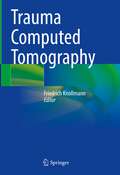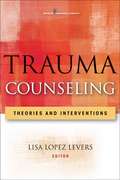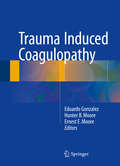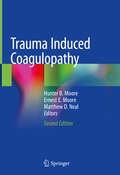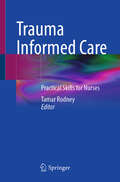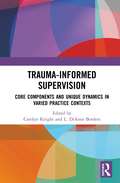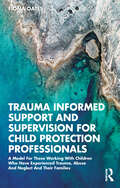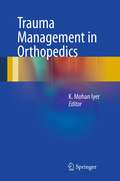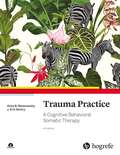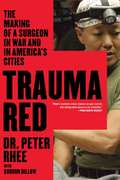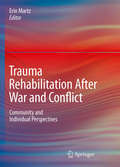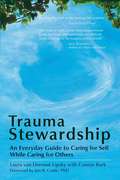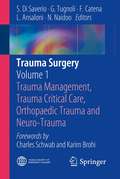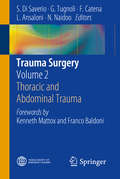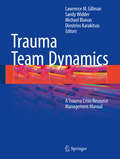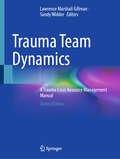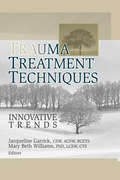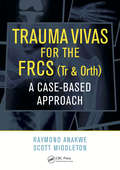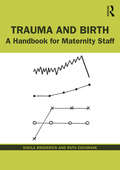- Table View
- List View
Trauma Centers: A Quick Guide
by Jeffrey S. YoungThis book is a quick guide to the key components of trauma center administration, management, and patient care. This book provides essential information for hospitals working toward trauma center designation, and for established trauma centers who want to improve their performance. This book provides trauma center personnel with a comprehensive overview of trauma center administrative structure, basic clinical operations, performance improvement and site visit preparation and examines the most common critical injuries seen by trauma centers to demonstrate how a properly functioning center addresses multiple priorities in critically ill patients. This book provides critical information for hospitals looking toward becoming a trauma center and established trauma centers that wants to improve their performance.
Trauma Computed Tomography
by Friedrich KnollmannThis book covers the use of computed tomography in trauma care. Over the last two decades, advancements in CT technology have significantly changed the technique and utilization patterns of computed tomography in trauma imaging. This book covers the entire spectrum of this application, structured by organ systems/body areas, corresponding to the subject structure and practice pattern of large academic radiology departments in the US. As a result, the reader benefits from the most advanced currently available sub-specialty expertise in the performance and interpretation of trauma CT studies. The book is intended to serve as an introduction to the subject as well as a reference to the trauma radiologist. Since current post graduate education in radiology does not offer any formally regulated fellowship training in this area, fellowship trained radiologists are typically not trained to cover the entire spectrum of trauma imaging that the practitioner may encounter when covering call assignments, especially outside of highly subspecialized academic medical centers. This book is intended to fill a need to provide subspecialized trauma CT training by integrating contributions from all involved radiology subspecialties in a single volume. This is an ideal guide for radiology residents, fellows, practicing radiologists, trauma surgeons, emergency medicine specialists, surgery residents and fellows, and interested medical students.
Trauma Counseling: Theories and Interventions
by Lisa Lopez LeversTrauma Counseling: Theories and Interventions is a much-needed textbook that focuses on relevant issues of traumatic, crisis-related, and disaster events from a systemic paradigm. The book discusses evidence-based trauma assessment and intervention techniques and integrates the latest findings from neuropsychology and psychopharmacology.
Trauma Doc to Redeem the Rebel
by Charlotte HawkesSparks fly with the trauma doc…but could she be the one to heal him? Find out in Charlotte Hawkes&’s latest Harlequin Medical Romance novel! WILL LETTING GO SET HIM FREE? Former army surgeon Connor is instantly drawn to ER doc Nell. She&’s beautiful, intelligent and the first person to really see him—ever. Rebel Connor has spent years running away from his painful past, relationships and himself. But since Nell understands being abandoned in childhood, as he was, could she be the one woman to finally break through his barriers…and redeem his barricaded heart?From Harlequin Medical: Life and love in the world of modern medicine.
Trauma Induced Coagulopathy
by Eduardo Gonzalez Hunter B. Moore Ernest E. MooreThis text is aimed at defining the current concepts that define trauma induced coagulopathy by critically analyzing the most up-to-date studies from a clinical and basic science perspective. It will serve as a reference source for any clinician interested in reviewing the pathophysiology, diagnosis, and management of the coagulopathic trauma patient, and the data that supports it. By meticulously describing the methodology of most traditional as well as state of the art coagulation assays the reader will have full understanding of the tests that are used to study trauma induced coagulopathy. The evolving use of blood products as well as recently introduced hemostatic medications are reviewed in detail. Trauma Induced Coagulopathy will also be a valuable source for quick reference to the clinician that is faced with specific clinical challenges when managing coagulopathy.
Trauma Induced Coagulopathy
by Hunter B. Moore Ernest E. Moore Matthew D. NealThe first edition of this publication was aimed at defining the current concepts of trauma induced coagulopathy by critically analyzing the most up-to-date studies from a clinical and basic science perspective. It served as a reference source for any clinician interested in reviewing the pathophysiology, diagnosis, and management of the coagulopathic trauma patient, and the data that supports it. By meticulously describing the methodology of most traditional as well as state of the art coagulation assays the reader is provided with a full understanding of the tests that are used to study trauma induced coagulopathy. With the growing interest in understanding and managing coagulation in trauma, this second edition has been expanded to 46 chapters from its original 35 to incorporate the massive global efforts in understanding, diagnosing, and treating trauma induced coagulopathy. The evolving use of blood products as well as recently introduced hemostatic medications is reviewed in detail. The text provides therapeutic strategies to treat specific coagulation abnormalities following severe injury, which goes beyond the first edition that largely was based on describing the mechanisms causing coagulation abnormalities.Trauma Induced Coagulopathy 2nd Edition is a valuable reference to clinicians that are faced with specific clinical challenges when managing coagulopathy.
Trauma Informed Care: Practical Skills for Nurses
by Tamar RodneyThis text outlines a practical guide for nurses and healthcare providers to provide care for individuals with varying traumatic histories with an informed perspective. Consideration of trauma as an acute experience to one that can develop into a post-traumatic stress disorder are explored. Additionally, the biological, behavioral, historical and cumulative basis of trauma are discussed as well as the family’s role in generational trauma. Trauma presents a complex multilayered experience that requires understanding to provide appropriate care. Trauma if often viewed as a physical experience with minimal consideration of the emotional and mental health aspects of these experiences. The perspective of unseen emotional scars is given descriptive graphic to allow the scars to be visualized and treated. The book includes perspectives across the globe from Thailand, UK, Philippines, India, Ireland, and Caribbean. As such this book will fill a gap in the field.
Trauma Informed Supervision: Core Components and Unique Dynamics in Varied Practice Contexts
by Carolyn Knight Di BordersSurvivors of trauma are disproportionately represented in agencies providing a broad range of behavioral, social, and mental health services. Practitioners in these settings must understand and be able to respond to survivors of trauma in ways that are empowering, normalize and validate their experiences and reactions, and minimize the risk of retraumatization. Practitioners also will be indirectly traumatized as a result of their work with trauma survivors. <p><p> Practitioners’ ability to help clients with histories of trauma depends upon clinical supervision that is trauma-informed. The trauma-informed supervisor has the dual responsibility of enhancing supervisees’ skills as trauma-informed practitioners and helping them manage the impact their work has on them. <p> Nevertheless, many clinical supervisors only have limited knowledge and training in trauma and may not recognize either the needs of those whom they supervise or the clients their supervisees serve. This book compiles important recommendations from trauma-informed practitioners, supervisors, and researchers who share their professional reflections and personal stories based on their hands-on experiences across mental health and medical contexts.
Trauma Informed Support and Supervision for Child Protection Professionals: A Model For Those Working With Children Who Have Experienced Trauma, Abuse And Neglect And Their Families
by Fiona OatesThis book presents a narrative approach to creating a supportive environment for health and human service practitioners who work with vulnerable children and their families—one of the most difficult and complex areas of practice. People working in these environments are routinely exposed to violence and trauma and commonly experience symptoms of traumatic stress as a result. Traditionally, human service and health care service organisations have struggled to support practitioners who experience primary and secondary trauma in either a preventative context or post exposure. Using contemporary trauma theory, this book provides a trauma-informed support and supervision framework for supervisors and managers of practitioners that recognises the uniqueness of the practice field, the diversity of practitioners who undertake the work and the diversity of contexts in which they work. It will be required reading for all human service and health professionals, including social workers, psychologists and nurses as well as teachers, counsellors and youth workers.
Trauma Junkie: Memoirs of an Emergency Flight Nurse
by Janice HudsonMemoirs of a flight nurse on a helicopter sent out to take trauma patients to hospitals in California.
Trauma Management in Orthopedics
by K. Mohan IyerThis book has been written by established Orthopedic Surgeons who have become dedicated specialists within their particular subspecialty. They have contributed by writing highly detailed chapters that educate the reader with the basic science, accepted fundamentals and most recent trends within the full range of trauma management in orthopedics. It is intended that this well illustrated and highly informative text book to provide orthopedic surgeons in training with comprehensive and relevant core knowledge on all aspects of trauma management orthopedics, and will become an essential guide for surgeons in training, providing step by step approaches to performing initial diagnosis, surgical procedures and post operative management.
Trauma Plan (Grace Medical Ser. #1)
by Candace CalvertSidelined by injuries from a vicious assault, chaplain Riley Hale is eager to return to her former duties as an ER nurse. But how can she show she's competent when the hospital won't let her attempt even simple tasks? Determined to prove herself, Riley volunteers at a controversial urban free clinic despite her fears about the maverick doctor in charge. Dr. Jack Travis defends his clinic like he's commander of the Alamo. He'll fight the community's efforts to shut its doors, even if he must use Riley Hale's influential family name to make it happen. As Riley strives to regain her skills. Jack finds that she shares his compassion--and stirs his lonely heart. Riley senses that beneath Jack's rough exterior is a man she can believe in. But when clinic protests escalate and questions surface about his past, Jack goes into battle mode, and Riley wonders if it's dangerous to trust him with her heart. Heart-stopping and... heart melting. A great read and one for your keeper shelf."--LYNETTE EASON, award-winning, bestselling author of the Women of Justice series--
Trauma Practice: A Cognitive Behavioral Somatic Therapy
by Anna B. Baranowsky J. Eric GentryThis popular, practical resource for traumatologists has been fully updated and expanded. It remains a key toolkit of cognitive behavioral somatic therapy (CBST) techniques for clinicians who want to enhance their skills in treating trauma and for those in training. The authors focus on helping practitioners find the right tools to guide their traumatized clients towards growth and healing but now also lay a deeper emphasis on the preparatory phase for therapists, including the therapists’ own ability to self-regulate their autonomic system during client encounters.
Trauma Red
by Peter Rhee Gordon DillowThe incredible life story of the trauma surgeon who helped save Congresswoman Gabby Giffords--from his upbringing in South Korea and Africa to the gripping dramas he faces in a typical day as a medical genius.Congresswoman Gabby Giffords is a household name: most people remember that awful day in Arizona in 2011 when she was a victim of an act of violence that left six dead and thirteen wounded. What many people don't know is that it was Dr. Peter Rhee who played a vital role in her survival. Born in South Korea, Rhee moved with his family to Uganda where he watched his public health surgeon father remove a spear from a man's belly--and began his lifelong interest in medicine. What came next is this compelling portrait of how one becomes a world class trauma surgeon: the specialized training, the mindset to make critical decisions, and the practiced ability to operate on the human body. Dr. Rhee is so eminent that when President Clinton traveled to China, he was selected to accompany the president as his personal physician. In Trauma Red we learn how Rhee's experiences were born from the love and sacrifices of determined parents, and of Rhee's own quest to become as excellent a surgeon as possible. Trauma Red chronicles the patient cases Dr. Rhee has handled over two decades on two distinct battle fronts: In Iraq and Afghanistan, where he served as a frontline US Navy surgeon trying to save young American soldiers, and the urban zones of Los Angeles and Washington, DC, where he has been confronted by an endless stream of bloody victims of civilian violence and accidents. Tough and outspoken, Dr. Rhee isn't afraid to take on the politics of violence in America and a medical community that too often resists innovation. His story provides an inside look into a fascinating medical world, a place where lives are saved every day.
Trauma Rehabilitation After War and Conflict
by Erin Martz"As foreign assistance flows into post-conflict regions to rebuild economies, roads, and schools, it is important that development professionals retain a focus on the purely human element of rebuilding lives and societies. This book provides perspective on just how to begin that process so that the trauma people suffered is not passed on to future generations long after the violence has stopped." - Amy T. Wilson, Ph.D., Gallaudet University, Washington, DC "This ground-breaking text provides the reader with an excellent and comprehensive overview of the existing field of trauma rehabilitation. It also masterfully navigates the intricate relationships among theory, research, and practice leaving the reader with immense appreciation for its subject matter." - Hanoch Livneh, Hanoch Livneh, Ph.D., LPC, CRC, Portland State University Fear, terror, helplessness, rage: for soldier and civilian alike, the psychological costs of war are staggering. And for those traumatized by chronic armed conflict, healing, recovery, and closure can seem like impossible goals. Demonstrating wide-ranging knowledge of the vulnerabilities and resilience of war survivors, the collaborators on Trauma Rehabilitation after War and Conflict analyze successful rehabilitative processes and intervention programs in conflict-affected areas of the world. Its dual focus on individual and community healing builds on the concept of the protective "trauma membrane," a component crucial to coping and healing, to humanitarian efforts (though one which is often passed over in favor of rebuilding infrastructure), and to promoting and sustaining peace. The book's multiple perspectives--including public health, community-based systems, and trauma-focused approaches--reflect the complex psychological, social, and emotional stresses faced by survivors, to provide authoritative information on salient topics such as: Psychological rehabilitation of U.S. veterans, non-Western ex-combatants, and civilians Forgiveness and social reconciliation after armed conflict Psychosocial adjustment in the post-war setting Helping individuals heal from war-related rape The psychological impact on prisoners of war Rehabilitating the child soldier Rehabilitation after War and Conflict lucidly sets out the terms for the next stage of humanitarian work, making it essential reading for researchers and professionals in psychology, social work, rehabilitation, counseling, and public health.
Trauma Rules 2: Incorporating Military Trauma Rules
by Timothy J. Hodgetts Lee TurnerTrauma Rules 2 retains its lively and fun presentation to help you remember the essential principles of trauma care and feel confident about handling and treating patients appropriately in the first hours of injury. Thoroughly expanded and updated, and now including military trauma rules, the second edition of this popular pocket book now offers: 70 easy-to-memorize rules covering the important aspects of trauma care clear, authoritative explanations and instructive illustrations the three principal stages of trauma management: approach to the patient, initial assessment and resuscitation, and investigation and definitive care Trauma Rules 2 is compiled especially for those dealing with the immediate and early management of the severely injured patient.
Trauma Stewardship: An Everyday Guide to Caring for Self While Caring for Others (Bk Life. Ser.)
by Connie Burk Laura van Dernoot LipskyThis beloved bestseller—over 180,000 copies sold—has helped caregivers worldwide keep themselves emotionally, psychologically, spiritually, and physically healthy in the face of the sometimes overwhelming traumas they confront every day.A longtime trauma worker, Laura van Dernoot Lipsky offers a deep and empathetic survey of the often-unrecognized toll taken on those working to make the world a better place. We may feel tired, cynical, or numb or like we can never do enough. These, and other symptoms, affect us individually and collectively, sapping the energy and effectiveness we so desperately need if we are to benefit humankind, other living things, and the planet itself. In Trauma Stewardship, we are called to meet these challenges in an intentional way. Lipsky offers a variety of simple and profound practices, drawn from modern psychology and a range of spiritual traditions, that enable us to look carefully at our reactions and motivations and discover new sources of energy and renewal. She includes interviews with successful trauma stewards from different walks of life and even uses New Yorker cartoons to illustrate her points."We can do meaningful work in a way that works for us and for those we serve," Lipsky writes. "Taking care of ourselves while taking care of others allows us to contribute to our societies with such impact that we will leave a legacy informed by our deepest wisdom and greatest gifts instead of burdened by our struggles and despair."
Trauma Surgery
by S. Di Saverio G. Tugnoli F. Catena L. Ansaloni N. NaidooTrauma surgery has increasingly become a specialized field inspired by different principles and philosophy. A good trauma surgeon is a surgeon who knows how to perform abdominal vascular, thoracic, urologic, gynecologic, and orthopaedic procedures and is able to repair multiple traumatic injuries in the best sequence possible. In this first volume, practical, up-to-date guidance is provided on the optimal critical care and ICU management of trauma patients. In addition, individual chapters focus on specific injuries in orthopaedic trauma (and especially spinal trauma) and neurotrauma, with the aim of providing a fresh view of the surgical approach and practical suggestions for improving the skills of treating surgeons. Educational issues and the organization of a trauma center are also covered. The volume will be a handy pocket guide for trainee surgeons and any surgeon, physician, or nurse who treats trauma patients. It will be particularly relevant for emergency department physicians, critical care and ICU doctors, orthopaedic surgeons, neurosurgeons, and professionals responsible for trauma care and decision making, programs of trauma education, or organization of a trauma center. Also available: Trauma Surgery Vol. 2: Thoracic and Abdominal Trauma
Trauma Surgery
by Salomone Saverio Gregorio Tugnoli Fausto Catena Luca Ansaloni Noel NaidooTrauma surgery has increasingly become a specialized field inspired by different principles and philosophy. A good trauma surgeon is a surgeon who knows how to perform abdominal, vascular, thoracic, urologic, gynecologic, and orthopaedic procedures and is able to repair multiple traumatic injuries in the best sequence possible. In this second volume the focus is exclusively on thoracic and abdominal trauma, with coverage of injuries to all regions. The surgical techniques employed in managing such trauma are carefully described with the aid of high-quality illustrations. Exploratory surgery (via either laparotomy or laparoscopy), damage control surgery, and definitive surgery are all fully covered, and attention is drawn to important technical tips and tricks. The volume will be a handy pocket guide for trainee surgeons who are beginning to deal with severe multiple trauma patients, as well as for all general or specialty surgeons and professionals (including scrub nurses and theatre staff) who are involved in trauma care and wish to keep abreast of developments in this complex field.
Trauma Team Dynamics
by Lawrence M. Gillman Sandy Widder Michael Blaivas Dimitrios KarakitsosThis is the first book exploring the unique dynamics created by a multidisciplinary trauma team and how crisis management strategies can improve teamwork and communication and, potentially, improve patient resuscitation outcomes. Crisis resource management (CRM) is integral to the way that we manage ourselves, team members, and patients during emergency situations. It is essentially the ability to translate knowledge of what needs to be done into effective actions during a crisis situation. Building on the revolutionary American College of Surgeons Advanced Trauma Life Support (ATLS®) course, Trauma Team Dynamics illustrates the integration of the principles of CRM to team dynamics throughout the resuscitation -from the scene, through pre-hospital care and transport, to the trauma bay, and finally to definitive care and beyond. The editors and contributors are international experts in trauma, critical care, emergency medicine, nursing, respiratory therapy, and pre-hospital care and include NASA- and United States military-affiliated experts. Trauma Team Dynamics is intended for use as both a day-to-day clinical resource and a reference text, and includes self-assessment questions as well as guidance on CRM curriculum design and implementation.
Trauma Team Dynamics: A Trauma Crisis Resource Management Manual
by Sandy Widder Lawrence Marshall GillmanThe majority of medical errors are non-technical in nature, stemming from faulty decision-making, asynchronous information gathering, lack of situational awareness and ineffective communication and team leadership. Reviews of accidents from other high-risk industries, including the airline industry, have had similar findings. This led the National Aeronautics and Space Administration (NASA) and the airline industry to develop crew (now crisis) resource management (CRM) training. These team-based training strategies address “non-technical” skills to counteract human error and improve team and patient safety. Medicine has begun adapting this training especially within the realms of anesthesia and critical care. Trauma surgery has been slower to utilize this work; however, simulation-based training is increasing in popularity. The first edition of Trauma Team Dynamics was a revolutionary book in the field of trauma care. It was the first text that integrated the complexities of trauma care but illustrated how these could be streamlined and improved through a team-based focus and training. CRM and team-based training has grown substantially in the past six years since this text was conceived, and there have been significant developments both in the breadth of the training as well as refinement in the topics covered, teaching methods utilized and strategies employed to overcome the multitude of challenges still faced in this area. The second edition of this text expands greatly on the initial CRM topics covered in the opening section of the book. Hot topics in CRM training, including the concepts of followership, and conflict resolution and highlights strategies such as mindfulness and others to manage stress and reduce burnout, are discussed. The text also expands into novel areas of trauma care including less invasive bedside endovascular treatments such as REBOA (Resuscitative Endovascular Balloon Occlusion of the Aorta) and a more in-depth discussion of teleresuscitation and trauma care in austere environments. Featuring 28 new chapters, the second edition of Trauma Team Dynamics is written by experts in trauma, critical care, emergency medicine, nursing, respiratory therapy, and pre-hospital care and include NASA- and United States military-affiliated experts. It is intended for use as both a day-to-day clinical resource and a reference text, and includes self-assessment questions as well as guidance on CRM curriculum design and implementation.
Trauma Treatment Techniques: Innovative Trends
by Mary Beth Williams Jacqueline GarrickExamine alternative techniques for dealing with post-traumatic stress disorderTrauma Treatment Techniques: Innovative Trends examines alternative approaches to "talk" therapies that help relieve stress in trauma survivors. Experts in a range of practice areas present mental health providers with methods that augment or go beyond traditional techniques, including art therapy, virtual reality, humor, residential programs, emotional freedom techniques (EFT), traumatic incident reduction (TIR), and thought field therapy (TFT). This unique book serves as a primer on new and creative means of working with combat veterans, survivors of child abuse, victims of rape and other violent crimes, refugees, victims of terrorism, and disaster survivors. Since the late 19th century, mental and medical health professionals, social workers, clinicians, and counselors have attempted to help patients mitigate symptoms and reduce distress by employing a variety of treatment techniques, methods, strategies, and procedures. Trauma Treatment Techniques: Innovative Trends represents a significant addition to the available literature on post-traumatic stress disorder (PTSD) and acute distress, providing therapists with much-needed options in their efforts to help trauma sufferers recover, find new meaning, and reach for new hopes and happiness.Trauma Treatment Techniques: Innovative Trends examines: debriefing interventions in school settings instructions and safeguards for using emotional freedom techniques (EFT) when debriefing in disaster situations the use of creative art therapies to reach out to war refugees the use of virtual reality-based exposure therapy (VRE) to desensitize Vietnam veterans with PTSD from traumatic memories humor as a healing tool repressed memory physiology and meridian treatment points in the body a six-step methodology for diagnosing PTSD a 90-day residential program for treatment of PTSD PTSD motivation enhancement (ME) groups autism as a potential traumatic stressor and much moreTrauma Treatment Techniques: Innovative Trends is an invaluable resource of inventive techniques that offer hope for recovery to anyone who has suffered life&’s worst injuries.
Trauma Vivas for the FRCS: A Case-Based Approach
by Raymond Anakwe Scott MiddletonThis new book is targeted at higher trainees in orthopaedic surgery preparing for the second part of the FRCS (Tr & Orth) exam. The exam involves a set of vivas during which a range of topics is discussed, the aim being to demonstrate trauma safety and competence rather than trauma expertise. Examiners may use props such as models, clinical pictures, clinical studies, and x-rays to introduce topics and initiate discussion. This book uses a similar model to allow the candidate to practise key topics for discussion with common presentations and histories, and high quality x-rays. The book lends itself to individual and small group learning as trainees prepare for their examinations.
Trauma and Birth: A Handbook for Maternity Staff
by Sheila Broderick Ruth CochraneOur book aims to provide those working in the maternity services, including those in general practices, with an understanding of what it means to be on the receiving end of care. Together with a description of various types of traumatic birth, we explain some of the reasons why women vary in terms of how traumatised they are by their birth experience. We provide information, encouragement and support for maternity staff to help them lessen the incidence of birth trauma, and to develop the confidence to help women when birth trauma does occur. The authors are a senior counsellor and an obstetrician, each with a long experience of helping women who have had difficult births. The approach of each to the subject is different but complementary. The book covers the psychological and emotional aspects of traumatic birth as well as the medical issues and includes a section on the effect of traumatic birth on the staff themselves. The market for this book is practising midwives and obstetricians, who by understanding the prevalence of traumatic birth and some of its causes can contribute to its reduction. Those in their training years will find it helpful at the outset of their practice. It will also be of interest to general practitioners, health visitors and counsellors.
Trauma and Combat Critical Care in Clinical Practice
by Sam D. HutchingsIntensive Care Medicine (or Critical Care, the terms are used interchangeably) is an evolving specialty both within the UK and worldwide. It has recently been established as a UK speciality in it's own right, and is at the centre of the modern acute hospital, responsible for managing the sickest and most complex patients. There is a growing cadre of critical care specialists in the UK, underpinned by a large number of doctors in training within the specialty. Management of patients with severe traumatic injury is provided by intensive care specialists, often in conjunction with a range of other professionals such as surgeons and interventional radiologists. The management of these patients, who have competing complex injuries can be challenging. Traumatic injury is recognised as a significant cause of preventable mortality and such patients are now clustered within Major Trauma Centres across the UK. The Defence Medical Services of the UK have spent the last 10 years managing patients with very severe traumatic injuries, first in Iraq and most recently in Afghanistan. The lessons learnt from this experience has filtered through to the NHS, resulting in many changes to established practice. Whilst several books have been published based on this experience, none have focused on the intensive care management of such patients, which represents a vital link in the chain of survival from injury to recovery.

